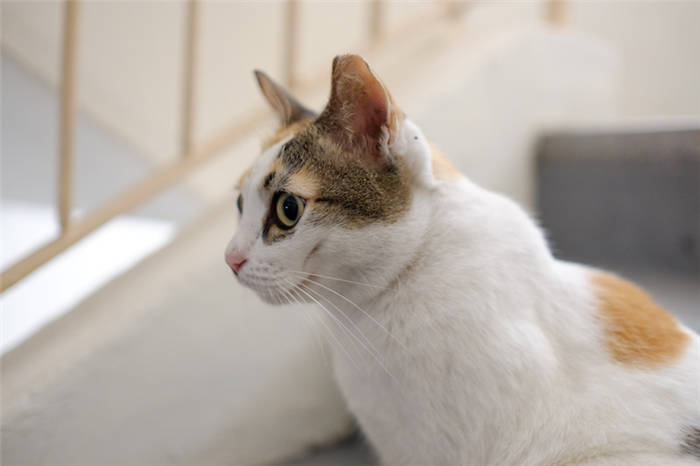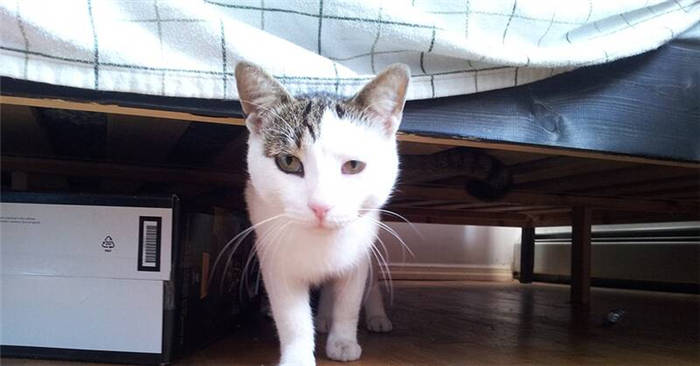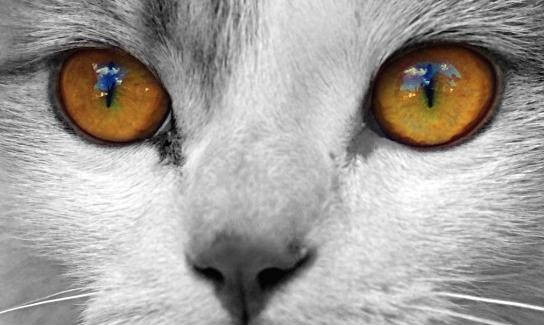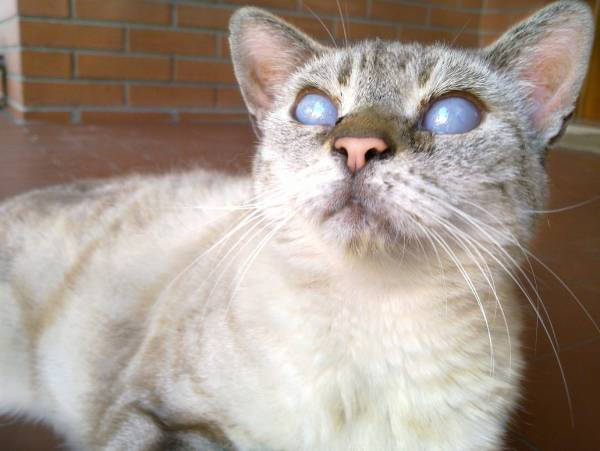This is interesting! Cats have the largest eyes of all higher vertebrate mammals. For example, if humans, eyes would have the same proportions in relation to the body, their size would reach 15-18 cm in diameter.

- Blindness in cats – how to know if the cat is blind, causes and treatment of the pathology
- Causes of blindness in cats
- Broken whiskers.
- Missing eyesight.
- How do I determine how well my pet can see? There is a suspicion that the cat has vision problems.
- How to behave
- Are your cat's eyes healthy? A test at home
- Signs of cat blindness
- Treatment of blindness in cats
- Conclusion
- Related posts:
- How do you find out if a cat can see?
- What causes blindness in cats?
Blindness in cats – how to know if the cat is blind, causes and treatment of the pathology
Blindness in pets, is a dangerous pathology characterized by the partial or complete loss of the cat's ability to see. A distinction is made between sudden blindness and also developing slowly. If the pet loses vision abruptly, there is a loss of orientation. In the case of physiological vision loss due to age-related changes, the animal has the ability to adjust to the limitations, successfully living on.
In the wild, vision loss for a cat is catastrophic and equates to death. The wild animal will not be able to hunt normally, leading to imminent death. Pets can be helped to cope with blindness; moreover, an attentive and caring owner who follows eye disease prevention can achieve positive results.
Causes of blindness in cats
Pets' eyes, which had wild felines ancestors, are a complicated, fragile and accurate organ. The damage of one of the components of the visual apparatus can lead to partial or complete loss of the cat's ability to see. Veterinary medicine distinguishes several types of vision disorders:
Blindness in a cat is divided into congenital and acquired, as well as complete or partial, when one or both eyes are affected. There are many factors that provoke the development of blindness in pets. Not all processes are irreversible. Some pathologies are reversible with timely help. It also happens so that the pet goes blind and cannot see for the rest of its life.
The task of the cat's owner is to pay attention to any changes in the animal's behavior and then contact a qualified specialist. This will allow to slow down the development of a certain pathology or completely return the ability to see to the animal.
The occurrence of blindness may be sudden, when the animal loses the ability to orient in space, and gradual. In the latter case, the cat has an opportunity to adapt to the image received by the brain. There are many causes of vision loss in pets. Veterinary medicine has divided them into two broad groups.
- Mechanical damage to the eye or concussion . Inflammatory processes in the nerve fibers that innervate the visual organ, resulting from infectious diseases or demyelination of nerve fibers. This pathology is characterized by narrowing of the field of vision, painful sensations when rotating the eyeball. Complete blindness may occur.
- Hypertension. This pathology, which provokes a sharp loss of vision, occurs when the pressure in the small capillaries increases, they are damaged and the blood penetrates into the nearby tissues. Hypertension leads to retinal detachment, which causes blindness, either sudden or gradual. In veterinary medicine, cases of hemorrhage in the anterior chamber of the eye with a sudden increase in blood pressure are diagnosed. The owner may notice the changes himself, and in the absence of timely help, the animal loses the ability to see.
Broken whiskers.
Whiskers, or vibrissae, are necessary for cats to navigate well in space. Mainly due to the vibrissae, even a totally blind cat can feel well, knowing where its owners are, how the furniture and other objects are arranged.
The vibrissae send nerve impulses to the brain, allowing the brain to draw a picture of the world around it. If you try to touch the cat's whiskers, it will absolutely reflexively cover its eyes. Such a safety measure is necessary to protect the cat's eyes in the darkness from possible branches or grasses.
A cat's whiskers are not just branches. They are supplied with blood and have nerve endings that lead directly to the trigeminal nerve. Related to this is the fact that the slightest air movement, the picture will be transmitted to the brain in the form of nerve impulses. A cat that has gone blind begins to shake its head, trying to determine the picture around it. This causes damage to the vibrissae. But it's not just loss of vision that can indicate brittle whiskers. Brittle cat whiskers can be the cause:
Because of this, a veterinarian should be consulted to determine the cause of a brittle mustache.
Missing eyesight.
Visual acuity in older cats, begins to decline gradually. And the predatory animal has time to adjust to the new lifestyle. The cat usually begins to sleep more, stops climbing on high surfaces, and refuses to play actively, preferring to be quiet. One of the signs of a cat's vision problems may be a missing eye. But for the loss of vision should not always be perceived as a lack of direct view of the cat.
The fact that the work of the central nervous system in cats has several characteristics. Thus, cats are better at identifying moving objects, so when a sudden movement, they can get scared. Proved and the fact that cats do not see well objects that are near. The best way an animal can see an object that is located at a distance of 2 to 6 meters. What is in the immediate vicinity – less than 2 meters from the eyes – is monitored by smell and touch.
It is believed that cats can see in complete darkness. In fact, in total darkness without a single source of light, cats see nothing. In order to navigate in space, the animal needs at least a slight source of light.
Noticing at least one of the signs of blindness in a cat described above, it is advisable to go to the veterinary clinic. It is better to let it be a false alarm than a serious illness of eyes or other internal organs.

Due to the high volume of questions received, free veterinary consultations have been temporarily suspended.
How do I determine how well my pet can see? There is a suspicion that the cat has vision problems.
In general, cats have some problems with their visual acuity. They see equivalently to the first line of the Snellen chart.
Now for the vision test: Not every cat will follow a cotton ball, have an adequate pupillary response or a threat reaction. That is why the tests have to be done several times. Can be in different conditions.
- Threat Reaction. The animal closes one eye and tests the vision of the other eye by waving a hand slightly in front of the eye. It is important not to create air currents , not to touch the vibrissae, not to rustle. The test is performed in a bright room and in a darkened room.
- Response of the pupils to light. We shine the flashlight in one eye – the pupil in this eye and a little in the second eye shrinks.
- Cotton ball. Get the cat's attention and drop a cotton ball in front of it. try this several times.
Now a few more peculiarities. Some of the disease is not visible. Not at all. A weaning of the eye in general is almost unchanged. And if the disease is only in one eye (e.g. partial retinal detachment), all reactions may seem normal to you.
Check the anterior segment, intraocular pressure, posterior segment. If the cat is over 9 years old, make sure to measure the blood pressure.
How to behave
If you suspect that your cat is seeing poorly, contact a veterinarian you trust immediately. Of course, there are some small tests you can do at home, such as shaking a toy (even a simple stick) in front of the cat and watching his reaction.
If he is not attracted to the game, especially if he is missing his gaze, he probably has a vision problem. It should be understood that the final answer must come only from a veterinarian; also because it is not enough to establish that your cat cannot see well, you must understand what pathology is causing the problem.
Are your cat's eyes healthy? A test at home
Problems with a cat's eyesight are often the last thing owners pay attention to, because the cat doesn't refuse food, doesn't stop playing and purring, and in most cases behaves as usual. One of the peculiarities of cats is that with partial or even complete loss of vision, they adapt very quickly. A cat will orient itself perfectly in its accustomed environment as long as all the things remain in their places, and the owner will not even suspect that his pet needs help.
Here's a list of simple questions that you can answer to see if your cat's eyes are okay.
– Are the eyes the same size?
– Are they the same shape?
– Are the pupils the same size?
– is the cornea clear?
– If you shine a light into the eyes (or just a bright light), will the pupils shrink? Are they the same size now?
– if you move your finger in front of the cat's eyes from left to right, will it follow it with both eyes?
– And if up and down?
– if you throw a small ball, will the cat see it?
– are the pupils blurred?
– Are there "blurred" areas on the cornea?
– Are the outlines of blood vessels showing through?
– Is there any discharge from the eyes?
– Does the cat have strabismus?
– Is there swelling of the eyelids?
– Is the third eyelid visible?
If the answers to any of these questions are not normal, that's a reason to see your veterinarian.
1 Wide, fully open eyes are the same size.
2 No signs of redness
3 The iris (the colored part of the eye) is clear green, in this case, with no spots or inclusions, clear and well visible about the entire surface.
4 Pupils are of the same size, but do not fill the entire iris (highly dilated pupils in a healthy animal may be only in case of too little light, action of some medications or in case of intense fear).
5 The cornea is clear, transparent, allowing all details of the eye to be seen clearly. There is no clouding or bleeding vessels.
6 The third eyelid does not protrude from the corners of the eyes.
7 There is no discharge or swelling.
Signs of cat blindness
The pet cannot report problems with image perception, so the responsibility falls on the owner. The owner of the pet must be sensitive to any changes in the behavior of the pet. Characteristic signs of the development of blindness in a cat, are:
- shaky gait;
- Uncertainty in walking and frequent collision with objects;
- Refusal of the pet to make jumps;
- problems with movement control – the animal may actively accelerate to run, then abruptly slow down;
- lack of eye glow in the dark;
- a large number of broken vibrissae;
- absent gaze into nothing.
It is important to understand that due to the peculiarities of the central nervous system, cats are much better at perceiving objects while moving. Therefore, a perfectly healthy cat may jump away from the owner when he moves sharply, not paying attention to him before.
The peculiarity also lies in the fact that cats cannot see in total darkness. A predatory animal needs a minimal source of light to orient itself. Cats' vision is considered crepuscular. Also, due to the peculiarities of the structure of the visual apparatus, cats do not distinguish well between objects located close to the animal. Household cats see well an object located at a distance of 2 to 6 meters from them. Everything closer is evaluated by other organs – smell and touch. A cat poking its face into the bowl is not always blind, it is just this way the pet studies the temperature of the food and its suitability for consumption.
Treatment of blindness in cats
After noticing changes in the pet's ability to see normally, it is necessary to go to a veterinary clinic for help. A veterinary specialist will prescribe a number of instrumental and laboratory tests to identify the type of pathology and the cause of its occurrence. Appointments are made:
Measuring the pressure inside the eye is done with special equipment that not all veterinary clinics have. Experienced specialists diagnose many pathologies of the visual apparatus based on a thorough examination.
The data obtained is the basis for the development of therapy. The specialist takes into account the individual characteristics of the patient (age, degree of neglect and type of pathological process). If possible, the doctor directs his or her efforts to eliminate the factors that provoke blindness in the animal – elimination of increased pressure in the arteries or the fight against infectious agents.
A blinded animal is helpless and cannot do without proper care from the owner. To make the pet feel comfortable, the owner must take a number of measures.
For example, items should be in familiar places – a cot for resting, a scratching post, bowls of water and food. Independent walks of a pet who has lost the ability to see are also forbidden. It is necessary to pay more attention to your pet, petting, talking to him, speeding up the process of adaptation to the new state.
Prevention of blindness lies in the timely detection of the pathological process. It is necessary to timely treat disorders of the visual apparatus, especially of the inflammatory type.
Keratitis, conjunctivitis, glaucoma and cataract can be treated in the early stages, up to persistent remission (refers to glaucoma and cataract). It is important to monitor the quality of the diet and visit the veterinarian regularly for preventive care.

Due to the high volume of questions received, free veterinary consultations have been temporarily suspended.
Conclusion
Blindness in cats is most often an acquired defect. Its occurrence can be judged by altered disoriented behavior, or blurred vision. Modern ophthalmologic examination methods will help confirm the diagnosis.
The exact identification of the cause of the pathology increases the chances of restoring vision.
However, blindness is not a sentence for pets. The owners will not have any problems either if they follow the rules of caring for the disabled pet.
Related posts:
Decreased vision for a puppy or adult dog is no small ordeal. Dog glasses or lenses are not yet available in optometrists. If a dog goes blind in both eyes, it's going to be tough. It's hard for a four-legged invalid to find his way to a bowl or a cot, let alone make a move.
A seizure is manifested by a series of sudden spontaneous muscle contractions of varying duration and intensity. The severity of such a condition varies from weak convulsive movements to shuddering of the whole body. Signs and causes of seizures.
The diagnosis of stroke is most often threatened in non-young dogs. However, the first signs of the deadly pathology should be known to pet owners. The severe disease is characterized by a complex of neurological symptoms and requires urgent treatment followed by rehabilitation.
Cats prefer to rest on their laps and climb into their owners' beds. Some people like a lively "warmer" on their back or stomach. Others can't stand cat hair on the bed or clothes. But all equally want to understand why a free-spirited cat lays down.
A dog scratching, hair falling out in wisps, clear signs of shingles. Photos will help you recognize the disease as quickly as possible. Is it possible to treat at home and how to prevent infection? Getting answers to these questions is extremely important: a sick dog is dangerous to.
Cats are born climbers. With equal ease, they scale fences, trees and kitchen cabinets. And usually land safely on their paws. Therefore, many owners do not know what to do if the cat has fallen badly. Despite the graceful animal's agility, t.
How do you find out if a cat can see?
Given the high adaptability of felines, vision problems, which are lost gradually, can be detected in fairly advanced stages. The pet becomes less mobile, sleeps more, prefers to move exclusively on floor surfaces, which does not cause much anxiety to the owners. It is possible to determine blindness in a cat by a number of the following signs:
- Refusal to jump.
- Cautious movement around the dwelling.
- It is difficult for the cat to control the sequence of steps, while walking, the animal stumbles to a gait and stops.
- A large number of broken whiskers are observed. With complete or partial loss of vision, the cat "feels the world" and picks up fluctuations in the air with its whiskers.
- There is no eye glare in the dark, and in the light, the gaze is unfocused.
- The animal crashes into objects that are not in their "usual" place.

Features of the cat's central nervous system, explain a number of nuances that can be mistaken for vision loss if the pet can't see:
- You, until you move. – Cats see objects better when they're on the move, hence the freezing at the sight of a mouse, and jumping up from surprise.
- Objects "under their noses" – The optimal distance for a cat's visual perception varies from 2 to 6 meters. All objects that are closer than 2 meters are monitored by sniffing and touching.
- In total darkness – The eyes of any mammal convert the picture into a nerve impulse by refracting rays of light. The cat sees perfectly well at dusk or with little light, but if there are no sources of light, the animal goes blind.
Pay attention! The Siamese cat's breed peculiarity is "double" vision, the pictures received from two eyes do not superimpose on each other. Visually, it is noticeable how the animal bows its eyes to "sharpen".
What causes blindness in cats?
Loss of vision, is a consequence of disease or a congenital disorder. Sudden blindness in cats is a rare phenomenon, most often associated with increased eye or intracranial pressure, brain circulation disorder, stroke. The completeness of treatment depends on the exact diagnosis and elimination of the cause of the disease. Things are much more complicated than they seem at first glance, the veterinarian needs to narrow it down from more than 20 root cause options, let's look at the main ones:
- Glaucoma – A collective term indicating a disease that causes an increase in intraocular pressure. Unfortunately, the primary development of glaucoma in cats is most often latent.
- Cataract – is a disease that affects the crystalline lens of the eye (clouding). Most often, older animals suffer from cataracts. Sight will be gradually lost.
- Uveitis – Inflammation of the vascular system of the eye. Symptoms: noticeable redness and soreness of eyes, decreased visual acuity, poor appetite, weight loss.
- Eye or brain tumors – A neoplasm physically presses on blood vessels, nerve endings, or parts of the brain. Other nerve disorders may occur in the background of vision loss.
- Retinal atrophy – A long, secretive process, leading to complete and irreversible loss of vision. Most often, the disease is inherited. There are no effective treatment methods.
- Hypertension – Hyperactivity of the thyroid gland, caused by kidney dysfunction or hormonal disorders, including diabetes. Hormonal dysfunction provokes the gradual detachment of the retina, resulting in atrophy.
Important: Craniocerebral trauma, intoxication or any other damage to the central nervous system may provoke blindness.






